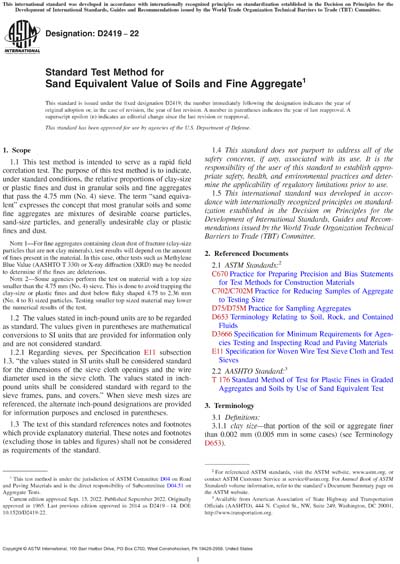Most recent
ASTM D2419-22
Standard Test Method for Sand Equivalent Value of Soils and Fine Aggregate
1.1This test method is intended to serve as a rapid field correlation test. The purpose of this test method is to indicate, under standard conditions, the relative proportions of clay-size or plastic fines and dust in granular soils and fine aggregates that pass the 4.75 mm (No. 4) sieve. The term "sand equivalent" expresses the concept that most granular soils and some fine aggregates are mixtures of desirable coarse particles, sand-size particles, and generally undesirable clay or plastic fines and dust.
Note 1:For fine aggregates containing clean dust of fracture (clay-size particles that are not clay minerals), test results will depend on the amount of fines present in the material. In this case, other tests such as Methylene Blue Value (AASHTO T 330) or X-ray diffraction (XRD) may be needed to determine if the fines are deleterious.
Note 2:Some agencies perform the test on material with a top size smaller than the 4.75 mm (No. 4) sieve. This is done to avoid trapping the clay-size or plastic fines and dust below flaky shaped 4.75 to 2.36 mm (No. 4 to 8) sized particles. Testing smaller top sized material may lower the numerical results of the test.
1.2The values stated in inch-pound units are to be regarded as standard. The values given in parentheses are mathematical conversions to SI units that are provided for information only and are not considered standard.
1.2.1Regarding sieves, per Specification E11 subsection 1.3, "the values stated in SI units shall be considered standard for the dimensions of the sieve cloth openings and the wire diameter used in the sieve cloth. The values stated in inch-pound units shall be considered standard with regard to the sieve frames, pans, and covers." When sieve mesh sizes are referenced, the alternate inch-pound designations are provided for information purposes and enclosed in parentheses.
1.3The text of this standard references notes and footnotes which provide explanatory material. These notes and footnotes (excluding those in tables and figures) shall not be considered as requirements of the standard.
1.4This standard does not purport to address all of the safety concerns, if any, associated with its use. It is the responsibility of the user of this standard to establish appropriate safety, health, and environmental practices and determine the applicability of regulatory limitations prior to use.
1.5This international standard was developed in accordance with internationally recognized principles on standardization established in the Decision on Principles for the Development of International Standards, Guides and Recommendations issued by the World Trade Organization Technical Barriers to Trade (TBT) Committee.
Content Provider
ASTM International [astm]






